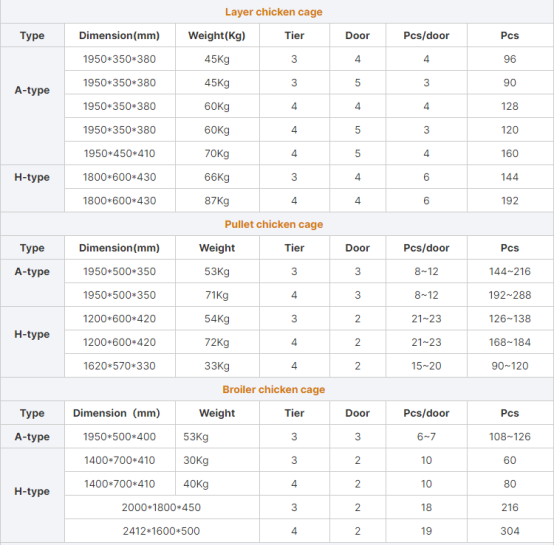Innovative Designs for Modern Chicken Cages and Their Benefits
Dec . 01, 2024 06:49 Back to list
Innovative Designs for Modern Chicken Cages and Their Benefits
The Impact of Chick Cages on Poultry Farming
In the modern agriculture landscape, poultry farming has evolved significantly, and one of the most critical factors influencing this evolution is the use of chick cages. Chick cages are specially designed enclosures that provide a controlled environment for raising chicks. While they are beneficial in many respects, they also raise ethical concerns and spur debates about the welfare of animals in agriculture.
The primary advantage of using chick cages is the ability to manage large volumes of chicks effectively and efficiently. In commercial poultry farming, space is at a premium. Chick cages enable farmers to optimize their available space by stacking cages vertically, thus increasing production capacity without requiring additional land. Furthermore, these cages often come with integrated feeding and watering systems, which reduce labor costs and ensure that chicks receive adequate nutrition and hydration. This efficiency not only benefits farmers economically but also helps meet the increasing global demand for poultry products.
Furthermore, chick cages provide a controlled environment that can be adjusted to meet the specific needs of the chicks
. Temperature, humidity, and ventilation can be carefully regulated to ensure optimal growth conditions. This control minimizes the risks of disease outbreaks, which can spread rapidly in unconfined settings. By maintaining a clean and controlled environment, farmers can reduce reliance on antibiotics, aligning with an increasing demand for more sustainable and humane farming practices.However, the use of chick cages has sparked considerable controversy, mainly due to animal welfare concerns. Critics argue that confining chicks in cages can lead to physical and psychological stress. Chickens are social animals and thrive in environments where they can exhibit natural behaviors such as pecking, scratching, and socializing. When confined to cages, chicks are often unable to engage in these behaviors, which can result in stress, aggression, and, ultimately, lower quality of life.
chick cages

The strict confinement associated with chick cages also raises questions about their long-term implications on the health of the birds. Many studies have indicated that poor living conditions can hinder growth and lead to health complications. Loose feathers, skeletal deformities, and a higher susceptibility to diseases are often observed in caged chickens, making the case for a more humane approach to poultry farming.
As the conversation surrounding animal welfare continues to grow, many farmers are exploring alternative housing solutions. Free-range and enriched cage systems aim to strike a balance between productivity and animal welfare. These systems allow chickens more freedom to roam, access outdoor spaces, and engage in natural behaviors while still providing farmers with some of the benefits of traditional caging systems.
Moreover, consumer demand for ethically sourced chicken products is rising. More people are becoming aware of the conditions in which their food is raised, leading them to seek out products from farms that prioritize animal welfare. As a result, farmers who adopt more humane practices may find themselves at an advantage in the marketplace. Organizations advocating for animal rights are also beginning to gain traction, leading to increased pressure on poultry farms to reconsider their use of traditional chick cages.
In conclusion, the use of chick cages in poultry farming is a double-edged sword. While they offer numerous benefits such as space efficiency, disease control, and ease of management, they also raise significant ethical concerns regarding the welfare of the animals confined within them. The future of poultry farming may lie in finding innovative approaches that ensure productivity without compromising animal welfare. As more farmers and consumers advocate for humane practices, the industry is likely to see a shift towards systems that honor the well-being of the animals that provide us with food. Balancing profitability and ethical responsibilities will be crucial as we move forward in the quest for sustainable agriculture practices that respect both human and animal needs.
-
Hot Sale 24 & 18 Door Rabbit Cages - Premium Breeding Solutions
NewsJul.25,2025
-
Automatic Feeding Line System Pan Feeder Nipple Drinker - Anping County Yize Metal Products Co., Ltd.
NewsJul.21,2025
-
Automatic Feeding Line System Pan Feeder Nipple Drinker - Anping County Yize Metal Products Co., Ltd.
NewsJul.21,2025
-
Automatic Feeding Line System - Anping Yize | Precision & Nipple
NewsJul.21,2025
-
Automatic Feeding Line System - Anping Yize | Precision & Nipple
NewsJul.21,2025
-
Automatic Feeding Line System-Anping County Yize Metal Products Co., Ltd.|Efficient Feed Distribution&Customized Animal Farming Solutions
NewsJul.21,2025






